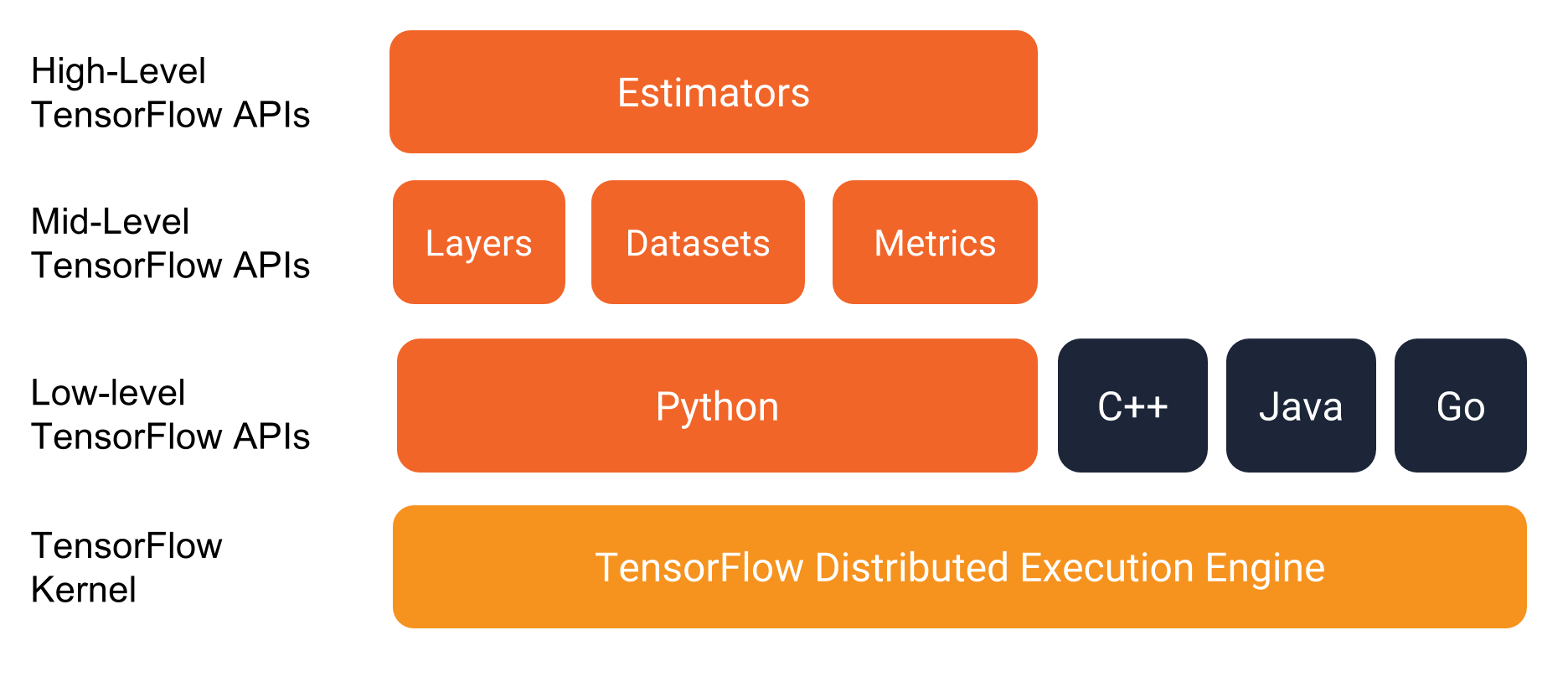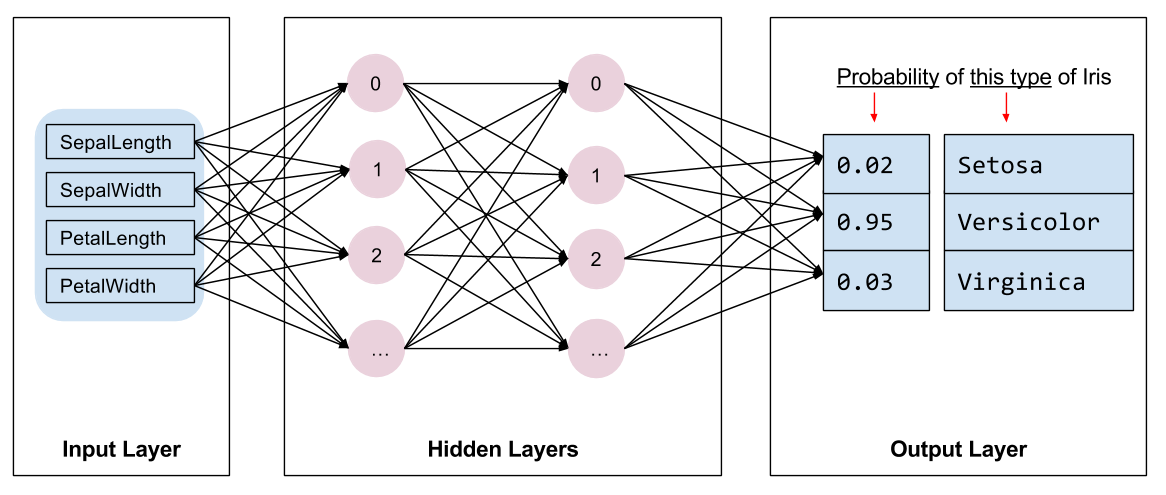This document introduces the TensorFlow programming environment and shows youhow to solve the Iris classification problem in TensorFlow.
Prerequisites
Prior to using the sample code in this document, you'll need to do thefollowing:
- Install TensorFlow.
- If you installed TensorFlow with virtualenv or Anaconda, activate your TensorFlow environment.
Install or upgrade pandas by issuing the following command:
pip install pandas
Getting the sample code
Take the following steps to get the sample code we'll be going through:
Clone the TensorFlow Models repository from GitHub by entering the following command:
git clone https://github.com/tensorflow/modelsChange directory within that branch to the location containing the examples used in this document:
cd models/samples/core/get_started/
The program described in this document ispremade_estimator.py.This program usesiris_data.pyto fetch its training data.
Running the program
You run TensorFlow programs as you would run any Python program. For example:
python premade_estimator.py
The program should output training logs followed by some predictions againstthe test set. For example, the first line in the following output shows thatthe model thinks there is a 99.6% chance that the first example in the testset is a Setosa. Since the test set expected Setosa, this appears to bea good prediction.
...
Prediction is "Setosa" (99.6%), expected "Setosa"
Prediction is "Versicolor" (99.8%), expected "Versicolor"
Prediction is "Virginica" (97.9%), expected "Virginica"
If the program generates errors instead of answers, ask yourself the followingquestions:
- Did you install TensorFlow properly?
- Are you using the correct version of TensorFlow?
- Did you activate the environment you installed TensorFlow in? (This is only relevant in certain installation mechanisms.)
The programming stack
Before getting into the details of the program itself, let's investigate theprogramming environment. As the following illustration shows, TensorFlowprovides a programming stack consisting of multiple API layers:

We strongly recommend writing TensorFlow programs with the following APIs:
- Estimators, which represent a complete model. The Estimator API provides methods to train the model, to judge the model's accuracy, and to generate predictions.
- Datasets, which build a data input pipeline. The Dataset API has methods to load and manipulate data, and feed it into your model. The Dataset API meshes well with the Estimators API.
Classifying irises: an overview
The sample program in this document builds and tests a model thatclassifies Iris flowers into three different species based on the size of theirsepals andpetals.

From left to right,Iris setosa (byRadomil, CC BY-SA 3.0),Iris versicolor (byDlanglois, CC BY-SA 3.0),and Iris virginica(by Frank Mayfield, CC BY-SA2.0).
The data set
The Iris data set contains four features and onelabel.The four features identify the following botanical characteristics ofindividual Iris flowers:
- sepal length
- sepal width
- petal length
- petal width
Our model will represent these features as float32 numerical data.
The label identifies the Iris species, which must be one of the following:
- Iris setosa (0)
- Iris versicolor (1)
- Iris virginica (2)
Our model will represent the label as int32 categorical data.
The following table shows three examples in the data set:
| sepal length | sepal width | petal length | petal width | species (label) |
|---|---|---|---|---|
| 5.1 | 3.3 | 1.7 | 0.5 | 0 (Setosa) |
| 5.0 | 2.3 | 3.3 | 1.0 | 1 (versicolor) |
| 6.4 | 2.8 | 5.6 | 2.2 | 2 (virginica) |
The algorithm
The program trains a Deep Neural Network classifier model having the followingtopology:
- 2 hidden layers.
- Each hidden layer contains 10 nodes.
The following figure illustrates the features, hidden layers, and predictions(not all of the nodes in the hidden layers are shown):

Inference
Running the trained model on an unlabeled example yields three predictions,namely, the likelihood that this flower is the given Iris species. The sum ofthose output predictions will be 1.0. For example, the prediction on anunlabeled example might be something like the following:
- 0.03 for Iris Setosa
- 0.95 for Iris Versicolor
- 0.02 for Iris Virginica
The preceding prediction indicates a 95% probability that the given unlabeledexample is an Iris Versicolor.
Overview of programming with Estimators
An Estimator is TensorFlow's high-level representation of a complete model. Ithandles the details of initialization, logging, saving and restoring, and manyother features so you can concentrate on your model. For more details seeEstimators.
An Estimator is any class derived from tf.estimator.Estimator. TensorFlowprovides a collection ofpre-made Estimators(for example, LinearRegressor) to implement common ML algorithms. Beyondthose, you may write your owncustom Estimators.We recommend using pre-made Estimators when just getting started withTensorFlow. After gaining expertise with the pre-made Estimators, we recommendoptimizing your model by creating your own custom Estimators.
To write a TensorFlow program based on pre-made Estimators, you must perform thefollowing tasks:
- Create one or more input functions.
- Define the model's feature columns.
- Instantiate an Estimator, specifying the feature columns and various hyperparameters.
- Call one or more methods on the Estimator object, passing the appropriate input function as the source of the data.
Let's see how those tasks are implemented for Iris classification.
Create input functions
You must create input functions to supply data for training,evaluating, and prediction.
An input function is a function that returns a tf.data.Dataset objectwhich outputs the following two-element tuple:
features- A Python dictionary in which:- Each key is the name of a feature.
- Each value is an array containing all of that feature's values.
label- An array containing the values of the label for every example.
Just to demonstrate the format of the input function, here's a simpleimplementation:
def input_evaluation_set():
features = {'SepalLength': np.array([6.4, 5.0]),
'SepalWidth': np.array([2.8, 2.3]),
'PetalLength': np.array([5.6, 3.3]),
'PetalWidth': np.array([2.2, 1.0])}
labels = np.array([2, 1])
return features, labels
Your input function may generate the features dictionary and label list anyway you like. However, we recommend using TensorFlow's Dataset API, which canparse all sorts of data. At a high level, the Dataset API consists of thefollowing classes:

Where the individual members are:
Dataset- Base class containing methods to create and transform datasets. Also allows you to initialize a dataset from data in memory, or from a Python generator.TextLineDataset- Reads lines from text files.TFRecordDataset- Reads records from TFRecord files.FixedLengthRecordDataset- Reads fixed size records from binary files.Iterator- Provides a way to access one data set element at a time.
The Dataset API can handle a lot of common cases for you. For example,using the Dataset API, you can easily read in records from a large collectionof files in parallel and join them into a single stream.
To keep things simple in this example we are going to load the data withpandas, and build our input pipeline from thisin-memory data.
Here is the input function used for training in this program, which is availablein iris_data.py:
def train_input_fn(features, labels, batch_size):
"""An input function for training"""
# Convert the inputs to a Dataset.
dataset = tf.data.Dataset.from_tensor_slices((dict(features), labels))
# Shuffle, repeat, and batch the examples.
return dataset.shuffle(1000).repeat().batch(batch_size)
Define the feature columns
A feature columnis an object describing how the model should use raw input data from thefeatures dictionary. When you build an Estimator model, you pass it a list offeature columns that describes each of the features you want the model to use.The tf.feature_column module provides many options for representing datato the model.
For Iris, the 4 raw features are numeric values, so we'll build a list offeature columns to tell the Estimator model to represent each of the fourfeatures as 32-bit floating-point values. Therefore, the code to create thefeature column is:
# Feature columns describe how to use the input.
my_feature_columns = []
for key in train_x.keys():
my_feature_columns.append(tf.feature_column.numeric_column(key=key))
Feature columns can be far more sophisticated than those we're showing here. Wedetail feature columns later on in our GettingStarted guide.
Now that we have the description of how we want the model to represent the rawfeatures, we can build the estimator.
Instantiate an estimator
The Iris problem is a classic classification problem. Fortunately, TensorFlowprovides several pre-made classifier Estimators, including:
tf.estimator.DNNClassifierfor deep models that perform multi-class classification.tf.estimator.DNNLinearCombinedClassifierfor wide & deep models.tf.estimator.LinearClassifierfor classifiers based on linear models.
For the Iris problem, tf.estimator.DNNClassifier seems like the best choice.Here's how we instantiated this Estimator:
# Build a DNN with 2 hidden layers and 10 nodes in each hidden layer.
classifier = tf.estimator.DNNClassifier(
feature_columns=my_feature_columns,
# Two hidden layers of 10 nodes each.
hidden_units=[10, 10],
# The model must choose between 3 classes.
n_classes=3)
Train, Evaluate, and Predict
Now that we have an Estimator object, we can call methods to do the following:
- Train the model.
- Evaluate the trained model.
- Use the trained model to make predictions.
Train the model
Train the model by calling the Estimator's train method as follows:
# Train the Model.
classifier.train(
input_fn=lambda:iris_data.train_input_fn(train_x, train_y, args.batch_size),
steps=args.train_steps)
Here we wrap up our input_fn call in alambdato capture the arguments while providing an input function that takes noarguments, as expected by the Estimator. The steps argument tells the methodto stop training after a number of training steps.
Evaluate the trained model
Now that the model has been trained, we can get some statistics on itsperformance. The following code block evaluates the accuracy of the trainedmodel on the test data:
# Evaluate the model.
eval_result = classifier.evaluate(
input_fn=lambda:iris_data.eval_input_fn(test_x, test_y, args.batch_size))
print('\nTest set accuracy: {accuracy:0.3f}\n'.format(**eval_result))
Unlike our call to the train method, we did not pass the stepsargument to evaluate. Our eval_input_fn only yields a singleepoch of data.
Running this code yields the following output (or something similar):
Test set accuracy: 0.967
Making predictions (inferring) from the trained model
We now have a trained model that produces good evaluation results.We can now use the trained model to predict the species of an Iris flowerbased on some unlabeled measurements. As with training and evaluation, we makepredictions using a single function call:
# Generate predictions from the model
expected = ['Setosa', 'Versicolor', 'Virginica']
predict_x = {
'SepalLength': [5.1, 5.9, 6.9],
'SepalWidth': [3.3, 3.0, 3.1],
'PetalLength': [1.7, 4.2, 5.4],
'PetalWidth': [0.5, 1.5, 2.1],
}
predictions = classifier.predict(
input_fn=lambda:iris_data.eval_input_fn(predict_x,
batch_size=args.batch_size))
The predict method returns a Python iterable, yielding a dictionary ofprediction results for each example. The following code prints a fewpredictions and their probabilities:
for pred_dict, expec in zip(predictions, expected):
template = ('\nPrediction is "{}" ({:.1f}%), expected "{}"')
class_id = pred_dict['class_ids'][0]
probability = pred_dict['probabilities'][class_id]
print(template.format(iris_data.SPECIES[class_id],
100 * probability, expec))
Running the preceding code yields the following output:
...
Prediction is "Setosa" (99.6%), expected "Setosa"
Prediction is "Versicolor" (99.8%), expected "Versicolor"
Prediction is "Virginica" (97.9%), expected "Virginica"
Summary
Pre-made Estimators are an effective way to quickly create standard models.
Now that you've gotten started writing TensorFlow programs, consider thefollowing material:
- Checkpoints to learn how to save and restore models.
- Datasets to learn more about importing data into your model.
- Creating Custom Estimators to learn how to write your own Estimator, customized for a particular problem.


























 593
593

 被折叠的 条评论
为什么被折叠?
被折叠的 条评论
为什么被折叠?








